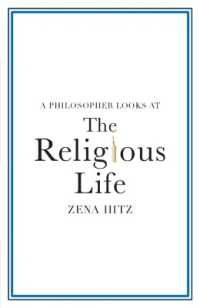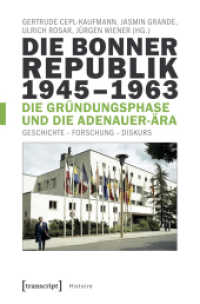- ホーム
- > 洋書
- > 英文書
- > Science / Mathematics
Full Description
The conservation of built heritage implies constant intervention. One form of intervention is reconstruction, which, in the context of disasters, usually tries to bring buildings and places back to their previous state and is contested in heritage discourses. This book challenges reconstruction as a replica to physically preserve damaged built heritage by critically examining a context of constant change resulting from earthquakes - Chile - advocating for the digital record to be an analytical basis for design, following the principles embedded in historical domestic architecture.
Beyond monumental heritage, the focus is on the living heritage of the historical settlements of Tarapacá, Zúñiga, and Lolol, built with local resources and sustainable techniques. The book proposes re-construction as an alternative methodology, based on 3D-laser-scanning, photography, and questionnaires, to analyse the as-built condition of earthquake-affected buildings, consider risk mitigation, and recognise adaptation to earthquakes and subsequent reconstructions. This is relevant for seismic-prone areas and built heritage at risk in general.
This book is aimed at researchers, academics, and practitioners in architectural conservation and is also a valuable resource for authorities and stakeholders involved in post-earthquake scenarios.
Contents
List of figures
List of abbreviations
Acknowledgements
Preface
Introduction
Situating the argument
Earthquakes in Chile
Re-construction and record
Structure of the book
Chapter 1: Built heritage conservation
1.1. A brief history of conservation
1.1.1. Initial attempts
1.1.2. Rome and beyond
1.1.3. Middle Ages
1.1.4. From the Renaissance
1.1.5. The becoming of heritage
1.2 Why conserve?
1.2.1. Living heritage: tangible and intangible
1.2.2. Sustainability and economic value
1.2.3. Tourism
1.2.4. Memory and the construction of history
1.3 How to conserve?
1.3.1. Concepts of intervention in built heritage
1.3.2. Reconstruction and re-construction
1.3.3. Time in built heritage restoration
1.3.4. Continuous conservation
1.3.5. Two intervention extremes
1.4. Concluding remarks
Chapter 2: Recording heritage buildings
2.1. Architectural representation, building and measuring
2.1.1 Building as recording
2.1.2. Architectural treatises
2.1.3. Other records
2.2. Surveying buildings
2.2.1. Hand-measuring method
2.2.2. Photography
2.2.3. 3D imaging
2.2.4. 3D scanning using projected light
2.2.5. 3D-laser-scanning
2.3. The rise of digital recording technologies
2.3.1. Products from the 3D record
2.3.2. Designing from the 3D scan data
2.3.3. The paradox of the complete record
2.3.4. Record and archive
2.3.5. Continuous modelling and design
2.3.6. Visual replica
2.4. Concluding remarks
Chapter 3: Record and reconstruction in the face of destruction
3.1. Potential destruction
3.1.1. The record
3.1.2. Rebuilding as replica
3.1.3. The paradox of the original
3.2 Recording for re-construction
3.2.1 Documenting to manage risk
3.2.2 Post-destruction assessment and documen
3.3 Post-earthquake intervention of heritage areas
3.3.1 Building techniques in reconstruction and re-construction
3.4. Concluding remarks
Chapter 4: Reconstruction of heritage areas in Chile
4.1. Built heritage in Chile
4.1.1. Continuous destruction because of earthquakes
4.1.2 Heritage stance
4.1.3. Recording heritage buildings
4.1.4 Mitigation of heritage damage
4.2. Case studies
4.2.1. Two earthquakes
4.2.2 Chilean heritage areas
4.2.3. Tarapacá
4.2.4. Zúñiga
4.2.5. Lolol
4.3. Reconstruction after earthquakes in Chile
4.3.1. Emergency period
4.3.2. Permanent housing
4.3.3. Post-earthquake surveys
4.3.4. 2005 Earthquake
4.3.5. 2010 Earthquake
4.4. Persisting challenges
4.4.1. Emergency period
4.4.2 Reconstruction process
4.5. Concluding remarks
Chapter 5: The record
5.1. Data capture on-site
5.1.1. Documenting the built environment
5.1.2. Inhabitants' perception
5.2. Visualisation
5.3 Limitations
5.4 The record for analysis
5.4.1. Post-earthquake surveys
5.4.2 Architectural design, heritage elements and the sustainability of the new "heritage" dwellings
5.4.3. The paradox of authentic reproduction
5.5. Concluding remarks
Chapter 6: Re-construction alternative
6.1. Documenting to mitigate risk
6.1.1. Mitigation retrofitting
6.1.2. Integrating inhabitants
6.2. Designing from the record
6.2.1. Time
6.2.2 Spatial use: the inhabited record
6.2.3 Sustainability and materiality
6.3.2. Spatial use: the inhabited record
6.3 Re-construction
6.3.1 Tarapacá - memory
6.3.2 Zúñiga - use
6.3.3. Lolol - in-between
6.4. Concluding remarks
Conclusions
Methodology
As a post-earthquake documenting tool
As a basis for analysis and design
Going beyond the buildings
Implications
New Buildings for old
Mitigation as conservation
Continuous transformation
Projections
References
Index








